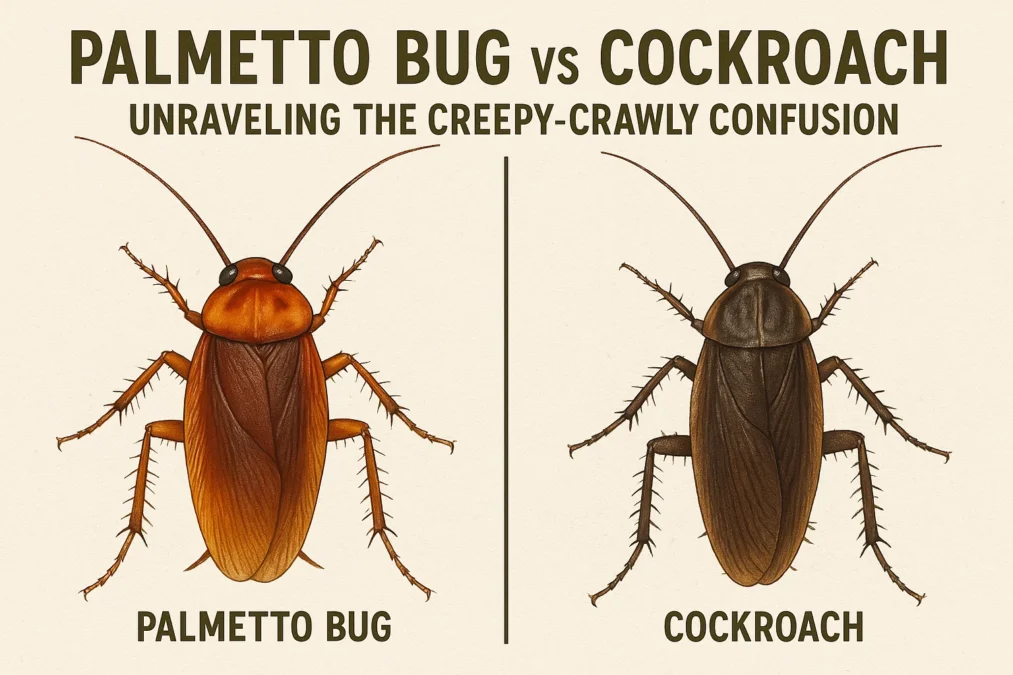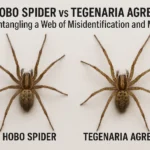Palmetto Bug vs Cockroach: You hear a scuttling in the kitchen, flip on the light, and see a large, dark, antennae-waving insect dart under the refrigerator. Your first thought might be a scream, followed by a frantic internal debate: “Was that a giant cockroach? Or is it one of those palmetto bugs I’ve heard about?” This moment of pest-identification panic is a common experience, especially in the warmer, humid climates of the American South. The terms “palmetto bug” and “cockroach” are often used interchangeably, leaving many homeowners wondering if there’s a real difference or if it’s just a fancy name for the same dreaded insect.
The truth is both simpler and more complex than you might imagine. Understanding the nuances between a palmetto bug and a cockroach is more than just a semantic exercise; it’s key to knowing what you’re up against, how concerned you should be, and the most effective strategies for prevention and control. This comprehensive guide will dive deep into the world of these resilient insects, exploring their biology, behavior, and the origins of their names. We’ll demystify the terminology, expose the facts, and equip you with the knowledge to protect your home from these unwelcome guests, whether you call them palmetto bugs, cockroaches, or something less polite entirely.
What Exactly is a Palmetto Bug?
Let’s cut to the chase: the term “palmetto bug” is not a formal scientific classification. You won’t find a species listed as Palmetto bugus in any entomology textbook. Instead, “palmetto bug” is a common name, a regional colloquialism that primarily refers to a specific type of cockroach, most commonly the American cockroach (Periplaneta americana). The name originates from the insect’s fondness for living in and around palmetto trees, a type of palm tree prevalent in states like South Carolina (the Palmetto State), Florida, Georgia, and other parts of the southeastern United States.
These bugs thrive in the damp, dark, and decaying organic matter found in the moist leaf bases (or “boots”) of sabal palmetto trees. However, the label isn’t always used precisely. In some regions, people may use “palmetto bug” to describe other large outdoor roach species, like the Smokybrown cockroach (Periplaneta fuliginosa), or even the Florida woods cockroach (Eurycotis floridana), which is also known colloquially as a “stinking roach” for the foul-smelling secretion it releases when threatened. So, when someone says “palmetto bug,” they are almost always talking about a cockroach, but they are specifically referring to a large, peridomestic species that is often associated with the outdoors but won’t hesitate to venture inside for food and shelter.
The use of the term “palmetto bug” is often seen as a gentler, less alarming alternative to the word “cockroach,” which carries heavy connotations of filth, infestation, and poor hygiene. Calling a large insect scurrying across the porch a “palmetto bug” can feel less intimidating than labeling it a giant cockroach, even though they are one and the same. This psychological distinction is a key reason why the nickname has persisted and gained such popularity. It creates a perceived separation between the “dirty” German cockroaches that infest kitchens and the “outdoor” roaches that just accidentally wandered in, even though both can pose problems.
The Scientific Lowdown on Cockroaches
To truly understand the palmetto bug vs cockroach discussion, we need to look at the bigger picture. Cockroaches are insects belonging to the order Blattodea. This order is ancient, with fossils indicating that roaches have been scurrying around the planet for over 320 million years, outliving the dinosaurs and proving their incredible evolutionary resilience. There are over 4,500 species of cockroaches worldwide, but before you panic, it’s crucial to know that the vast majority of these species live in wild habitats like forests, caves, and burrows and play a vital role in ecosystems as decomposers, breaking down leaf litter and other organic waste.
Of these thousands of species, only a handful have evolved to live in close association with humans, becoming what we classify as pests. These are the cockroaches that give the entire order a bad name. The most common pest species include the German cockroach (Blattella germanica), the American cockroach (Periplaneta americana), the Oriental cockroach (Blatta orientalis), and the Brown-banded cockroach (Supella longipalpa). Each of these species has its own preferred habitats and behaviors, but they all share a common trait: they thrive in environments where humans provide them with easy access to food, water, and shelter.
This is where the science meets the semantics. The American cockroach is a prime example of a species that wears two hats. To an entomologist, it’s Periplaneta americana. To a homeowner in Charleston, it’s a palmetto bug. It’s the same insect, just with a different label based on context and perception. Recognizing that “cockroach” is the broad umbrella term for the entire group of insects, while “palmetto bug” is a common name for a subset of that group, is the fundamental key to unlocking this mystery. All palmetto bugs are cockroaches, but not all cockroaches are palmetto bugs.
Key Differences Between Palmetto Bugs and Other Cockroaches
While a palmetto bug is technically a cockroach, the common usage of the term hints at some real biological and behavioral distinctions between the species it refers to (like the American cockroach) and other common pest roaches, most notably the German cockroach. These differences are critical for proper identification and effective control.
The most immediate difference is their preferred habitat and relationship with human dwellings. German cockroaches are almost entirely indoor pests. They have evolved to live exclusively in human-built structures. You will find them nesting in the warm, humid crevices of kitchens and bathrooms—behind appliances, inside cabinets, under sinks. They are completely dependent on the indoor environment for survival and reproduce at an alarming rate. In contrast, the American cockroach, or palmetto bug, is considered peridomestic, meaning it lives primarily outdoors but will readily invade homes and buildings in search of resources. Their natural habitats include mulch beds, leaf litter, tree holes, sewer systems, and storm drains. An indoor sighting is often an individual scout or a sign that outdoor conditions have become unfavorable (e.g., extreme heat or heavy rain).
Their appearance, while similar in overall roach-like build, also has notable variations. American cockroaches (palmetto bugs) are one of the largest pest species, typically measuring between 1.5 to 2 inches in length. They are reddish-brown with a distinctive yellowish figure-8 pattern on the back of their head shield (pronotum). German cockroaches are significantly smaller, only about 0.5 to 0.6 inches long, and are light brown or tan with two dark, almost parallel stripes running down the back of their pronotum. Oriental cockroaches are darker, often shiny black, and about an inch long. These visual cues are your first line of defense in identifying your unwelcome guest.
A Detailed Comparison Table
This table breaks down the key characteristics to help you visually distinguish between the common “palmetto bug” (American cockroach) and other frequent pest cockroach species.
| Feature | American Cockroach (“Palmetto Bug”) | German Cockroach | Oriental Cockroach |
|---|---|---|---|
| Scientific Name | Periplaneta americana | Blattella germanica | Blatta orientalis |
| Size | 1.5 – 2 inches (Large) | 0.5 – 0.6 inches (Small) | 1 – 1.25 inches (Medium) |
| Color | Reddish-brown | Light brown/Tan | Dark glossy brown/Black |
| Key Marking | Yellowish figure-8 pattern on pronotum | Two dark parallel stripes on pronotum | No distinctive markings, uniform color |
| Wings | Fully developed wings, capable of short flights | Fully developed wings, rarely fly | Short wings on males, wingless females |
| Preferred Habitat | Outdoors (mulch, trees, sewers), peridomestic | Indoors (kitchens, bathrooms), highly domestic | Damp, cool areas (basements, drains, leaf litter) |
| Infestation Likelihood | Lower (usually solitary invaders) | Very High (rapid breeding, large infestations) | Moderate (can establish indoor populations) |
Why the Terminology Matters: Beyond Semantics
You might be thinking, “If it’s a roach, it’s a roach. Why does the name matter?” The distinction between calling it a palmetto bug or an American cockroach is far more than just a linguistic preference; it has real-world implications for a homeowner. Correct identification is the absolute cornerstone of effective pest control. Misidentifying a pest means you will likely use the wrong treatment methods, wasting time, money, and effort while the problem persists.
For instance, if you have a German cockroach infestation and mistakenly believe they are just occasional “palmetto bugs” wandering in from outside, you might only spray the perimeter of your home. This would do little to nothing to address the German roaches nesting and breeding in the warmth behind your refrigerator. Eradicating a German cockroach infestation requires a comprehensive, multi-pronged approach targeting their indoor harborages with gels, baits, and growth regulators. Conversely, if you see a large American cockroach indoors, your strategy should focus on exclusion—sealing entry points and reducing outdoor attractants—rather than assuming you have a widespread indoor nest.
Furthermore, the terminology impacts the perceived severity of the problem. German cockroaches are strongly associated with unsanitary conditions and can rapidly multiply into an overwhelming infestation. They are also known to be significant triggers for asthma and allergies, especially in children, due to the allergens in their saliva, droppings, and shed skin. American cockroaches can carry pathogens as well, but a single sighting does not necessarily signal a breeding infestation within the home; it might just be an intruder from the garden. Understanding this difference can help you assess the situation rationally and respond with the appropriate level of concern and action.
The Health Risks Associated with Cockroaches
Regardless of what you call them, cockroaches pose genuine health concerns. They are not just a nuisance; they are potential vectors of disease and powerful allergens. Cockroaches are scavengers that traverse some of the filthiest places on earth, including sewers, garbage piles, and decaying matter. Their spiny legs and bodies easily pick up bacteria, viruses, fungi, and parasite eggs. As they wander across kitchen countertops, food preparation surfaces, and stored food, they can mechanically transmit these pathogens, contaminating your environment.
Studies have shown that cockroaches can carry pathogens like Salmonella (which causes food poisoning), Staphylococcus, Streptococcus, and E. coli. They can also spread organisms that cause dysentery and typhoid fever. While the direct link to disease outbreaks is less common than with other pests like flies, the risk of contamination is still very real and a primary reason to eliminate them from your home. Their mere presence in a food-handling area is a serious sanitary issue.
Perhaps an even more widespread health impact is their role as allergenic triggers. Cockroach allergens, which are proteins found in their saliva, feces, and shedding body parts, become part of household dust. For sensitive individuals, exposure to these allergens can cause severe allergic reactions, including sneezing, skin rashes, and itchy eyes and throat. Most critically, they are a major exacerbating factor for asthma, particularly in children living in urban environments. The National Pest Management Association estimates that cockroach allergens are a trigger for 7-8% of the U.S. population. This makes controlling an infestation, particularly of prolific indoor breeders like German cockroaches, a matter of public health, not just comfort.
How to Prevent an Infestation of Palmetto Bugs and Cockroaches
An ounce of prevention is worth a pound of cure, and this old adage rings especially true when dealing with cockroaches. These insects are masters of exploitation, taking advantage of any tiny opening or careless crumb. A strong defense is your best offense. Prevention strategies can be broadly divided into two categories: exclusion and sanitation. Exclusion is about building a fortress that they cannot penetrate, while sanitation is about removing all incentives for them to even try.
Exclusion starts with a thorough inspection of your home’s exterior. Seal every crack and crevice you can find using a quality silicone-based caulk. Pay special attention to areas where utility pipes and wires enter your home, as these are common superhighways for pests. Install tight-fitting screens on windows and vents, and use door sweeps on all exterior doors to eliminate the gap at the threshold. Since palmetto bugs are attracted to light, consider using yellow bug lights in outdoor fixtures rather than standard white lights, which are less attractive to insects.
Sanitation is about eliminating the food, water, and shelter that cockroaches need to survive. Inside, this means never leaving dirty dishes in the sink, storing food (including pet food) in airtight containers, and promptly cleaning up any crumbs or spills. Take out the trash regularly and use cans with tight-sealing lids. Reduce clutter, especially cardboard boxes and paper bags, which provide ideal hiding spots. Outside, keep your yard tidy by raking up leaf litter, moving firewood piles away from the house, and ensuring mulch isn’t piled directly against the foundation. Fix leaky faucets and downspouts to eliminate excess moisture, and keep gutters clean to prevent water accumulation.
Effective Methods for Elimination and Control
Despite your best preventive efforts, you may still encounter a cockroach or palmetto bug inside your home. When that happens, it’s important to have a strategic plan for elimination. The methods you choose will depend on the scale of the problem and the specific species you’re dealing with. For the occasional American cockroach (palmetto bug) invader, DIY methods are often sufficient. For a suspected German cockroach infestation, professional intervention is almost always the most effective and long-lasting solution.
For DIY control, start with insecticidal baits and gels. These are highly effective because they use the cockroach’s own behavior against it. The roaches are attracted to the bait, consume it, and then return to their harborage to die. Other roaches then feed on the poisoned carcass and feces, creating a domino effect that can eliminate a entire nest. Place these baits in areas where you’ve seen activity, like under sinks, behind appliances, and in dark corners. Boric acid powder, carefully applied in thin layers in voids and crevices (away from children and pets), can also be a effective desiccant that kills roaches on contact.
However, for persistent problems or full-blown infestations, calling a professional exterminator is strongly recommended. Pest control experts have access to more powerful, targeted insecticides and the knowledge to use them safely and effectively. They can perform a detailed inspection to locate harborages you would never find and create a customized Integrated Pest Management (IPM) plan. IPM focuses on long-term prevention and uses a combination of techniques, including inspection, monitoring, exclusion, and targeted chemical controls as a last resort. This approach is more sustainable and effective than simply spraying pesticides everywhere and hoping for the best.
Wolf Spider vs Brown Recluse: The Ultimate Guide to Identification, Bites, and Safety
Debunking Common Myths About Palmetto Bugs and Cockroaches
The world of pests is rife with myths and old wives’ tales, and cockroaches are no exception. Believing these myths can lead to ineffective control methods and a lot of frustration. Let’s set the record straight on a few of the most common misconceptions. One of the most pervasive myths is the idea that cockroaches are invincible and could survive a nuclear apocalypse. While it’s true that cockroaches are more resistant to radiation than humans, they are not indestructible. They would succumb to extremely high levels of radiation, just like most other organisms. Their real superpower is their resilience to many common pesticides and their ability to survive on minimal resources.
Another common myth is that seeing one cockroach, especially a large palmetto bug, means there is only one. Unfortunately, cockroaches are rarely solitary creatures. For every one you see scurrying across the floor at night, there are likely dozens, if not hundreds, hiding in the shadows. German cockroaches, in particular, live in large aggregations. Even with American cockroaches, a single indoor sighting could indicate a large population living just outside your home, ready to exploit any opportunity to come inside. It’s always best to assume that one is a sign of a larger issue and to investigate further.
A third myth is that a clean house will never have cockroaches. While poor sanitation is a major contributing factor and will undoubtedly attract and sustain cockroaches, even the cleanest homes can have an infestation. Cockroaches are attracted to more than just obvious filth; they need very little food to survive. A few crumbs, a pet’s water dish, or even the glue on the back of a postage stamp can be enough. They can be brought into a clean home in grocery bags, cardboard boxes, or second-hand appliances. Cleanliness is a powerful deterrent, but it is not an impenetrable forcefield against these determined pests.
The Ecological Role of Cockroaches
It’s difficult to think positively about an insect we so despise in our homes, but it’s important to remember that cockroaches play a significant and beneficial role in the broader ecosystem. The vast majority of cockroach species are not pests; they are forest dwellers that serve as nature’s premier recyclers. These wild cockroaches feed on decaying organic matter like fallen leaves, dead wood, and animal carcasses. By breaking down this material, they accelerate the decomposition process, releasing nutrients back into the soil and making them available for plants to use. In this sense, they are crucial decomposers, much like earthworms and fungi.
They also serve as a vital source of food for a wide range of other animals. Many species of birds, small mammals, reptiles, amphibians, and even other insects prey on cockroaches. In a healthy ecosystem, they are an important link in the food web. The problem arises when a few opportunistic species evolved to take advantage of a new, incredibly rich ecosystem: the human habitat. Our homes provide them with constant warmth, abundant food, and endless hiding places, all without the natural predators that keep their populations in check outdoors.
So, while the American cockroach living in your garden mulch (and earning the name palmetto bug) is simply doing its job as a decomposer, the same insect that enters your kitchen is crossing a boundary and becoming a pest. The goal of pest control is not to eradicate all cockroaches from the planet—an impossible and ecologically damaging task—but to manage the small number of species that have chosen to live in conflict with us, and to defend the boundaries between our homes and the natural world where they belong.
FAQ: Your Palmetto Bug and Cockroach Questions Answered
Are palmetto bugs and cockroaches the same thing?
Yes, essentially. A “palmetto bug” is a common nickname for a specific type of cockroach, most often the American cockroach (Periplaneta americana). The term is used primarily in the southeastern United States and originates from the insect’s habit of living in palmetto trees. So, all palmetto bugs are cockroaches, but not all cockroaches are referred to as palmetto bugs. The nickname often creates a perceived distinction between large outdoor roaches and the smaller, more dreaded indoor German cockroaches.
Why do people call them palmetto bugs instead of cockroaches?
People often use the term “palmetto bug” as a euphemism because the word “cockroach” carries strong negative associations with filth, poor hygiene, and infestation. Calling a large insect that flies in from outside a “palmetto bug” feels less alarming and less personally embarrassing than saying a “giant cockroach” is in the house. It psychologically distances the outdoor, “accidental” invader from the indoor, “filthy” pest, even though they belong to the same family of insects.
Do palmetto bugs infest homes like other cockroaches?
While American cockroaches (palmetto bugs) can and do enter homes, they are less likely to establish large, breeding infestations inside a structure compared to German cockroaches. They are peridomestic, meaning they prefer to live outdoors but come inside for food and water. However, if they find a consistently damp, dark, and food-rich environment like a basement, crawl space, or sewer access point, they can certainly settle in and multiply. An indoor population is a serious issue that requires action.
Can palmetto bugs fly?
Yes, American cockroaches, or palmetto bugs, have fully developed wings and are capable of flying, albeit somewhat awkwardly. They typically use their wings to glide from high places, like trees, down to lower surfaces. They are also attracted to lights and may fly towards a lit window or porch light at night, which is a common way they end up inside homes. Their ability to fly often adds to the shock and alarm of encountering one.
What attracts palmetto bugs to a house?
Palmetto bugs are attracted to houses by the same things that attract all pests: food, water, and shelter. Outside, they are drawn to overgrown vegetation, leaf litter, mulch beds, and woodpiles right next to the foundation. Outdoor pet food and water bowls are also big attractants. They can enter through tiny cracks seeking moisture from leaky pipes, damp basements, or clogged gutters. At night, they are also attracted to the light shining from windows and doors.
Conclusion
The great debate of palmetto bug vs cockroach ultimately boils down to a matter of terminology and perception, rooted in real entomological differences between species. Understanding that a “palmetto bug” is not a distinct biological entity but rather a colloquial name for the American cockroach—a large, outdoor-loving species common in the South—empowers you to correctly identify your pest problem. This identification is the critical first step toward an effective solution. Whether you’re dealing with a solitary palmetto bug that wandered in from the garden or a full-blown German cockroach infestation brewing behind your walls, the response required is vastly different.
Armed with the knowledge from this guide, you can now move past the fear and confusion and take proactive, targeted action. Focus on the pillars of prevention: exclusion by sealing entry points and sanitation by eliminating attractants. Remember that even the cleanest home can have an encounter, and that these insects, however reviled, play a beneficial role in the world outside our doors. The goal isn’t to wage a war of annihilation on all cockroaches, but to protect your home from the few species that see it as an extension of their habitat. So the next time you see that large, scurrying insect, you’ll know exactly what you’re dealing with and, more importantly, exactly what to do.



